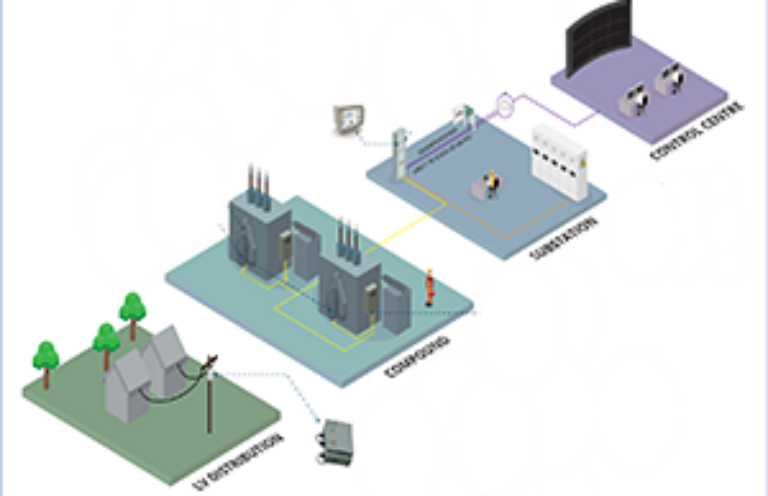Why the grid needs whole system voltage control

UK’s all-electric future raises voltage challenge for DSOs
Changes in patterns of consumer demand, as well as modes of electricity generation and distribution, will have profound implications for Distribution System Operators (DSOs ) in the next decade – not least in terms of the solutions they may need to adopt to maintain customer services and control voltages within regulatory limits.
The next 10 years
The UK electricity infrastructure was built on an After Diversity Maximum Demand (ADMD) model, with projections based on fossil fuels. Heating was gas-powered, transport was oil-powered and electricity itself was overwhelmingly generated by centralised plants burning coal, gas and oil. Customers consumed electricity in predictable and slow-changing patterns.
The concept of ADMD is still relevant today but the original model (ACE 49 – ENA, 1981. “Report on Statistical Method for Calculating Demands and Voltage Regulations on LV Radial Distributions Systems”, Energy Networks Association, 1981) needs updating.
Now, as usage patterns are changing, with more electric vehicles, heat pumps and photovoltaics coming on stream, the difference between minimum and maximum load seen on LV feeders is increasingly exaggerated – and not all on the same feeders at the same time. This drives the need for increased regulation of voltage further down the network.
Voltage warning from OFGEM
“Cleaner energy is pushing our systems beyond their design parameters.”
Many households in 2031 will be all electric – heating, showers, cars, cooking and innumerable gadgets. This will have profound effects at periods of peak demand. The ADMD model used to specify typical local grids was probably from a 40-year-old era of ‘traditional load’. The problem will almost certainly be exacerbated in rural communities towards the end of networks.
In reality, local grids are far from standardised. Some are relatively modern and built with sufficient resilience to adapt to most of the changes ahead. Many are older and already stretched up to or beyond their original capacity.
In addition to controlling voltages during unprecedented future peaks in demand, DSOs must also factor in the effects of new distributed generation sources. Traditional power stations delivered electricity predictably. Solar and wind generators are affected by weather, often locally, for long or short periods. Clouds pass over the sun. Winds gust. Voltages can fluctuate dramatically.
A further level of complexity is being added with the emergence of energy storage solutions, ranging from domestic and industry-scale batteries, to flywheels and hydrogen fuel cells. However, many of these should serve to flatten the peaks in electricity supply and demand, with a calming effect on voltage fluctuations.
Electric vehicles biggest game changer?
There are now (Summer 2021) more than 500,000 electric vehicles and plug-in hybrids on UK roads (source: https://www.nextgreencar.com/electric-cars/statistics/. Image courtesy EDF Energy). Still a relatively small number, but their combined market share rose from 7.3% of total car sales in 2019 to 13.9% in 2020. With the UK’s ban on new internal combustion cars just over eight years away, and EV prices expected to tumble, that’s going to lead to an awful lot of 7kw home chargers being installed, very soon. National Grid has predicted 11 million UK EVs by 2030.
Indeed, the University of Strathclyde has warned that wholesale adoption of domestic EV chargers could potentially overwhelm the capacity of existing LV grids.
The university has developed a Wire Resilience Impact Scenario Calculator (WRISC) to look at the implications of a fast-electrifying UK. The starting point of its future-gazing is an assumed ADMD of 9kw per household, which means that with current patterns of consumption (gas heating and conventional vehicles), the wires in most networks have plenty of resilience. It then goes on to examine the impact of successively higher rates of uptake for heat pumps (HPs) and EVs.
Strathclyde concludes that even a relatively high level of HP uptake in a smart grid scenario would not stretch DSO grid capacity too far. However, HPs combined with widespread adoption of EVs, using domestic fast chargers, could exceed the capacity of wires in typical networks. DSOs can download the Excel-based WRISC decision tool to perform their own modelling at http://www.esru.strath.ac.uk/EandE/Web_sites/13-14/WRISC/index.html.
Smarter control for smarter grids
Electricity North West has been one of the pioneers of whole system voltage control, with its Smart Street project – https://www.enwl.co.uk/go-net-zero/innovation/key-projects/smart-street/ – “using innovative voltage control technology, which will enable our networks and customers’ appliances to perform more efficiently and make it easier for low carbon technologies to connect to the electricity network in the future”.
Horses for courses
Fundamentals Managing Director Vincent Thornley said: “Voltage control can be a challenge at all parts of the grid – and the solutions are very much horses for courses. For example, problems at the ends of LV networks can often be solved with simple plug-and-play voltage regulators (bottom left), removing or deferring the need for expensive reinforcement.
“Moving up to HV (the 6-20 kV level, depending on the network), the general principle is that those which are furthest from the primary substation tend to have the greatest need for voltage control – say, 15 or 20 of the 30 or 40 transformers on that feeder.
“Some argue that the best solution is to apply tapchangers to distribution transformers, but this will only address regulation issues for one distribution transformer, yet is not selective enough to address differing requirements in different LV feeders, so we believe is not a cost-effective option. A more cost- effective and, at the same time, targeted approach is in-line regulation on HV feeders), combined with tactically installed low voltage regulators at a local level.
“Far from being a piecemeal approach, this is a more precise and intelligent strategy for solving voltage problems across the grid, at lowest cost.”
Learn more

- Article
- Automatic Voltage Control (AVC/AVR)
New challenges. New tools.

- Article
- Automatic Voltage Control (AVC/AVR)
- Control Scheme Services
- LV Network Control
- Tapchanger Services
Fundamentals partners with EcoJoule Energy to optimise power grids across Europe

- Article
- Automatic Voltage Control (AVC/AVR)
Fundamentals powers Northern Powergrid’s carbon reducing BEET-Box

- Article
- Automatic Voltage Control (AVC/AVR)